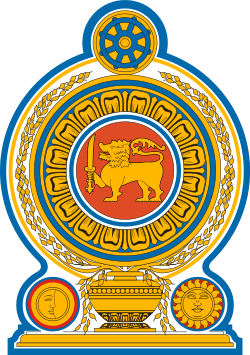Sri Lankan Constitution of 1972
 |
| This article is part of a series on the politics and government of Sri Lanka |
|
|
Political parties |
|
|
|
|
Foreign policy |
|
Related issues
|
The Sri Lankan Constitution of 1972 is the constitution of Sri Lanka. It is Sri Lanka's first republican constitution, and its second constitution[nb 1] since the independence of the country in 1948. The constitution changed the country's name to Sri Lanka from Ceylon, and proclaimed it as an independent republic nation.[1][2][3][4][5] Therefore, the official name of the country was "Republic of Sri Lanka" and the constitution was known as "1972 Republican Constitution". The new constitution was promulgated on 22 May 1972.[1]
History
The arrival of the Portuguese in 1505 and their interest in the island dramatically changed the political landscape. The island had been ruled by seven kingdoms, and the Kingdom of Kotte was firstly occupied by the Portuguese. Another foreign influence was the Dutch from 1640 until 1796, when the British came along. Unlike the Portuguese and Dutch, the British occupied the entire island and as a Crown colony and was known as British Ceylon from 1815 until 1948.[6]
Ceylon had been introduced to various legislative systems including the idea of a constitution. The Soulbury Constitution was the first constitution as an independent nation. Ceylon gained independence on 4 February 1948, while the Monarchy of the United Kingdom remained as Head of State.[7] Executive power was nominally vested in the Sovereign of Ceylon. Governance of Ceylon came from the parliament, which was not completely independent. Several weaknesses of the 1947 Soulbury Constitution demanded a new constitution.[8]
United Front, led by the Sri Lanka Freedom Party of Sirimavo Bandaranaike won the 1970 general election with a two third majority and Bandaranaike became the Prime Minister. She convened a group to draft the new constitution, which was promulgated on 22 May 1972.[9][2]
Impact and criticism
The constitution paved the way for Sri Lanka to become a republic, cut the final ties with UK's colonial influence. [10][11] It received both negative and positive reactions. The constitution was considered as reflecting a leftist ideology since the ruling government was leftist. Also, it was criticized as a radical departure which failed to consider the minority communities of Sri Lanka and their basic rights, including religion and language.[12][13]
See also
Note
- ↑ Soulbury Commission introduced Soulbury Constitution in 1947
References
- 1 2 "Constitutional reforms since independence". Government of Sri Lanka. Retrieved 23 January 2015.
- 1 2 "Ceylon became the 'Republic of Sri Lanka'". Daily News. 22 May 2009. Retrieved 21 May 2014.
- ↑ Hubert Peiris, Gerald. "The Republic of Sri Lanka". Encyclopædia Britannica. Retrieved 23 January 2015.
- ↑ "Sri Lanka". Encyclopedia.com. Retrieved 23 January 2015.
- ↑ "The 1978 Constitution". Library of Congress Country Studies. Retrieved 25 January 2015.
- ↑ M. Leonard, Thomas (2013). Encyclopedia of the Developing World. Routledge. p. 2184. ISBN 978-1-135-20508-9.
- ↑ "Independence". Library of Congress Country Studies. Retrieved 25 January 2015.
- ↑ Vitarana, Tissa. "Why have we forgotten our Republican Day – May 22?". The Island. Retrieved 25 January 2015.
- ↑ Vitarana, Tissa (19 May 2012). "The Republic of Sri Lanka: Forty Years of Complete Independence". The Island. Retrieved 25 January 2015.
- ↑ Udagama, Deepika (5 January 2014). "The Fragmented Republic: Reflections on the 1972 Constitution of Sri Lanka". Centre for Policy Alternatives. Retrieved 25 January 2015.
- ↑ Wickramaratne, Jayampathy. "The 1972 Constitution in Retrospect" (PDF). Tissa Jayatilleke. Retrieved 25 January 2015.
- ↑ Coomaraswamy, Radhika. "The 1972 Republican Constitution in the Postcolonial Constitutional Evolution of Sri Lanka" (PDF). Retrieved 25 January 2015.
- ↑ "The first Republican Constitution is declared". PACT. Retrieved 25 January 2015.
Further reading
- Lakshman, W. D.; Allan Tisdell, Clement (2000). Sri Lanka's Development Since Independence: Socio-economic Perspectives and Analyses. Nova Publishers. p. 301. ISBN 978-1-56072-784-2.
- Omar, Imtiaz (1996). Rights, Emergencies, and Judicial Review. Martinus Nijhoff Publishers. p. 395. ISBN 9789041102294.